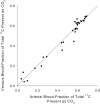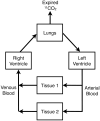Equivalence of arterial and venous blood for [11C]CO2-metabolite analysis following intravenous administration of 1-[11C]acetate and 1-[11C]palmitate
- PMID: 23306135
- PMCID: PMC4620575
- DOI: 10.1016/j.nucmedbio.2012.11.011
Equivalence of arterial and venous blood for [11C]CO2-metabolite analysis following intravenous administration of 1-[11C]acetate and 1-[11C]palmitate
Abstract
Purpose: Sampling of arterial blood for metabolite correction is often required to define a true radiotracer input function in quantitative modeling of PET data. However, arterial puncture for blood sampling is often undesirable. To establish whether venous blood could substitute for arterial blood in metabolite analysis for quantitative PET studies with 1-[(11)C]acetate and 1-[(11)C]palmitate, we compared the results of [(11)C]CO2-metabolite analyses performed on simultaneously collected arterial and venous blood samples.
Methods: Paired arterial and venous blood samples were drawn from anesthetized pigs at 1, 3, 6, 8, 10, 15, 20, 25 and 30min after i.v. administration of 1-[(11)C]acetate and 1-[(11)C]palmitate. Blood radioactivity present as [(11)C]CO2 was determined employing a validated 10-min gas-purge method. Briefly, total blood (11)C radioactivity was counted in base-treated [(11)C]-blood samples, and non-[(11)C]CO2 radioactivity was counted after the [(11)C]-blood was acidified using 6N HCl and bubbled with air for 10min to quantitatively remove [(11)C]CO2.
Results: An excellent correlation was found between concurrent arterial and venous [(11)C]CO2 levels. For the [(11)C]acetate study, the regression equation derived to estimate the venous [(11)C]CO2 from the arterial values was: y=0.994x+0.004 (r(2)=0.97), and for the [(11)C]palmitate: y=0.964x-0.001 (r(2)=0.9). Over the 1-30min period, the fraction of total blood (11)C present as [(11)C]CO2 rose from 4% to 64% for acetate, and 0% to 24% for palmitate. The rate of [(11)C]CO2 appearance in venous blood appears similar for the pig model and humans following i.v. [(11)C]-acetate administration.
Conclusion: Venous blood [(11)C]CO2 values appear suitable as substitutes for arterial blood samples in [(11)C]CO2 metabolite analysis after administration of [(11)C]acetate or [(11)C]palmitate
Advances in knowledge and implications for patient care: Quantitative PET studies employing 1-[(11)C]acetate and 1-[(11)C]palmitate can employ venous blood samples for metabolite correction of an image-derived tracer arterial input function, thereby avoiding the risks of direct arterial blood sampling.
Copyright © 2013 Elsevier Inc. All rights reserved.
Figures







Similar articles
-
Whole-Body Biodistribution, Dosimetry, and Metabolite Correction of [11C]Palmitate: A PET Tracer for Imaging of Fatty Acid Metabolism.Mol Imaging. 2017 Jan-Dec;16:1536012117734485. doi: 10.1177/1536012117734485. Mol Imaging. 2017. PMID: 29073808 Free PMC article.
-
Measuring plasma fatty acid oxidation with intravenous bolus injection of 3H- and 14C-fatty acid.J Lipid Res. 2013 Jan;54(1):254-64. doi: 10.1194/jlr.P031153. Epub 2012 Oct 23. J Lipid Res. 2013. PMID: 23093549 Free PMC article. Clinical Trial.
-
[11C]palmitate kinetics across the splanchnic bed in arterial, portal and hepatic venous plasma during fasting and euglycemic hyperinsulinemia.Nucl Med Biol. 2006 May;33(4):521-8. doi: 10.1016/j.nucmedbio.2006.02.003. Epub 2006 May 2. Nucl Med Biol. 2006. PMID: 16720244
-
Validation of the [1,2-13C]acetate recovery factor for correction of [U-13C]palmitate oxidation rates in humans.J Physiol. 1998 Nov 15;513 ( Pt 1)(Pt 1):215-23. doi: 10.1111/j.1469-7793.1998.215by.x. J Physiol. 1998. PMID: 9782171 Free PMC article. Clinical Trial.
-
Combining image-derived and venous input functions enables quantification of serotonin-1A receptors with [carbonyl-11C]WAY-100635 independent of arterial sampling.Neuroimage. 2012 Aug 1;62(1):199-206. doi: 10.1016/j.neuroimage.2012.04.047. Epub 2012 May 2. Neuroimage. 2012. PMID: 22579604 Clinical Trial.
Cited by
-
Cardiorenal ketone metabolism in healthy humans assessed by 11C-acetoacetate PET: effect of D-β-hydroxybutyrate, a meal, and age.Front Physiol. 2024 Oct 21;15:1443781. doi: 10.3389/fphys.2024.1443781. eCollection 2024. Front Physiol. 2024. PMID: 39497705 Free PMC article.
-
Impaired cardiometabolic responses to glucagon-like peptide 1 in obesity and type 2 diabetes mellitus.Basic Res Cardiol. 2013 Jul;108(4):365. doi: 10.1007/s00395-013-0365-x. Epub 2013 Jun 14. Basic Res Cardiol. 2013. PMID: 23764734 Free PMC article. Clinical Trial.
-
Radiosynthesis, Preclinical, and Clinical Positron Emission Tomography Studies of Carbon-11 Labeled Endogenous and Natural Exogenous Compounds.Chem Rev. 2023 Jan 11;123(1):105-229. doi: 10.1021/acs.chemrev.2c00398. Epub 2022 Nov 18. Chem Rev. 2023. PMID: 36399832 Free PMC article. Review.
-
Combination GLP-1 and Insulin Treatment Fails to Alter Myocardial Fuel Selection vs. Insulin Alone in Type 2 Diabetes.J Clin Endocrinol Metab. 2018 Sep 1;103(9):3456-3465. doi: 10.1210/jc.2018-00712. J Clin Endocrinol Metab. 2018. PMID: 30020461 Free PMC article. Clinical Trial.
-
Whole-Body Biodistribution, Dosimetry, and Metabolite Correction of [11C]Palmitate: A PET Tracer for Imaging of Fatty Acid Metabolism.Mol Imaging. 2017 Jan-Dec;16:1536012117734485. doi: 10.1177/1536012117734485. Mol Imaging. 2017. PMID: 29073808 Free PMC article.
References
-
- Fox KA, Abendschein DR, Ambos HD, Sobel BE, Bergmann SR. Efflux of metabolized and nonmetabolized fatty acid from canine myocardium. Implications for quantifying myocardial metabolism tomographically. Circ Res. 1985;57(2):232–43. - PubMed
-
- Brown MA, Myears DW, Bergmann SR. Validity of estimates of myocardial oxidative-metabolism with C-11 acetate and positron emission tomography despite altered patterns of substrate utilization. J Nucl Med. 1989;30(2):187–93. - PubMed
-
- Walsh MN, Geltman EM, Brown MA, Henes CG, Weinheimer CJ, Sobel BE, et al. Noninvasive estimation of regional myocardial oxygen-consumption by positron emission tomography with C-11 acetate in patients with myocardial-infarction. J Nucl Med. 1989;30(11):1798–808. - PubMed
-
- Clark VL, Kruse JA. Arterial catherization. Crit Care Clin. 1992;8:687–97. - PubMed
Publication types
MeSH terms
Substances
Grants and funding
LinkOut - more resources
Full Text Sources
Other Literature Sources

